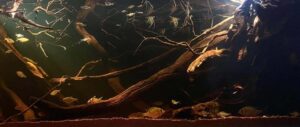Rio Putumayo The gushing river in Peru
_st place in Biotope Aquarium Design Contest 2022

Volume of aquarium: 412.5L
Dimensions of aquarium: 150×50×55CM
List of fishes: Hemigrammus rodwayi
Gasteropelecusmaculatus
Pterophyllum scalare
Biotodoma cupido
B. splendens
Sturisoma
Corydoras leucomelas
Paracheirodonaxelrodi
List of plants: Anubias nana
Description of Decorations and Substrate: Daniel Brahlinsha Boutique Brown Sands Duggan Azalea Branches Thai Branches Vine Sun Root Vine, Purple Grapefruit Flowwood Red Rock Long-Eye Leaves Palm Leaves Lazy Leaves and Online Shopping Several Unknown Leaves. Overall visual comfort and natural
Description of Equipment: Water pump: Bert TS2 6000 flow
lamp: 4500K 65007w floodlight * 2 10W 6500k * 1
nec Lamp 4500k * 1 30w
Ma Yin Magic lamp PLUS * 1 30w
Filter material: The second generation spiral bacteria house 50 protein cotton 1000G
Sedimentation tank on the fish tank filtration
Water Parameters: The water temperature: 26 ° C
Water quality buffer index: KH 7
Total hardness of water: GH 9
PH of water: PH 6.5
Additional Info: Change 100L of water in the fish tank every 7 days
Aquarium video::
Description of the Area Surrounding the Biotope: The Amazon river originally did not have a general name, each branch and each section had its own local name, after 1502, just called “the river”, later called “Marana” in Spanish, meaning “entanglements”, “confusion”, later called the Amazon river. With a total length of 6440 kilometers, the Amazon river is controlled by the equatorial low pressure and is rich in precipitation, making it the largest river in the world. It flows through the whole Amazon plain, and flows through most of the tropical rain forest to make it less sand content, and the water temperature is relatively constant during the year without ice.
The source of amazon river is a 5597 meters above sea level in the andes region of central Havana, a stream of mizpah, m peak, the amazon river from west to east, acceptance from the andes dongpo, Guyana plateau along the southern slope, Brazil plateau in the west and north of more than 1000 rivers, form the vast amazon river system network, including 7 length of more than 1600 kilometers, There are 20 tributaries with a length of more than 1,000 kilometers, including 17 tributaries with a length of more than 1,500 kilometers. The Amazon flows through eight countries in South America, 87 percent of them in Brazil. Known as the “King of rivers” and as Brazilians proudly call it the “Sea of rivers,” the Amazon has nearly 16,000 tributaries and supports an incredible diversity of species.
Putumayo River in Spanish, Rio Putumayo. Tributaries of the Amazon River. It is 1,609 km (1,000 mi) long. It originates in La Cocha Lake in the Andes mountains near Pasto, Colombia, and is called the Guamues River upstream. Southeast flows through the forested plains of South America, after the Port of Assis in Colombia known as the Putumayo River. Also known as the Ica River. It continues to flow southeast through the rainforest and forms most of the borders between Colombia and Ecuador and Between Colombia and Peru. Most of South America has a tropical rainforest climate and savanna climate. The climate is warm and humid, mainly tropical, continental seasons are not significant. Except mountain areas, the average temperature in the coldest month in winter is above 0℃ (increasing with altitude). In the tropical areas of the main parts of the mainland, the average annual temperature exceeds 20℃. The mean temperature of the hottest month in summer in most regions is between 26.8℃. The influence of the Andes mountains leads to the temperate continental climate in the east, the banded tropical desert climate and Mediterranean climate in the west of South America, the Alpine climate in the Andes mountains, and the subtropical monsoon and monsoon humid climate in the southeast of South America, which is also the reason for the lower environmental temperature in Peru.
Description of the Underwater Landscape of the Biotope: There is little vegetation in the habitat, and it is worth mentioning that the immortals used to live among the submerged roots of rotten wood, between the river bottom sand stones, reddish sand composed of sand, floating in the water and branches, and large trees on the shore.
Description of the Habitat Parameters: Living in freshwater rivers, pH range 5.5-7.5. Should be weak acidic soft water quality, the appropriate water temperature is 22-30℃
List of Fishes and Invertebrates Occurring in the Nature Biotope: Gasteropelecusmaculatus
Sturisoma
Corydoras leucomelas
Pterophyllum scalare
B. splendens
Corydoras atropersonatus
Biotodoma cupido
Paracheirodonaxelrodi
S. aequifasciata
Pygocentrus nattereri (Serrasalmus nattereri) and so forth
List of Plants Found in the Nature Biotope: Attalea speciosa
Brosimum
Iryamthera paraensis
Lecythis paraensis
Cedrela fissilis
Lamanonia glabra
Iresine herbstii
Threats to the Ecology of the Biotope: As aquarium hobbyists, we should call for more natural, love yourself, respect nature, to protect those precious magic species, let them thrive, rather than the interests of the trigger of overfishing, and gathering, when the species extinction is the most important thing is people to nature, to cut down trees and burning forests, build massive pollution project, will break the local flow, Species are dying out every day in the world, which is also a sad place. I really hope that beautiful species will not only be seen in encyclopedias in the future. We respect life and Revere nature.
Sources of Information:
Network public number domestic video website books mouse fish spring and Autumn mouse fish map code light fish map code and so on
